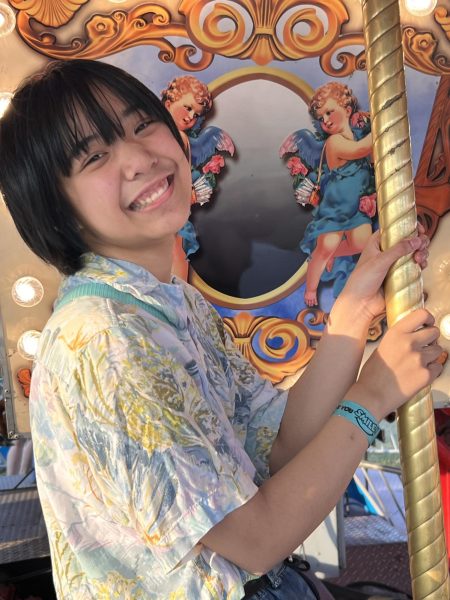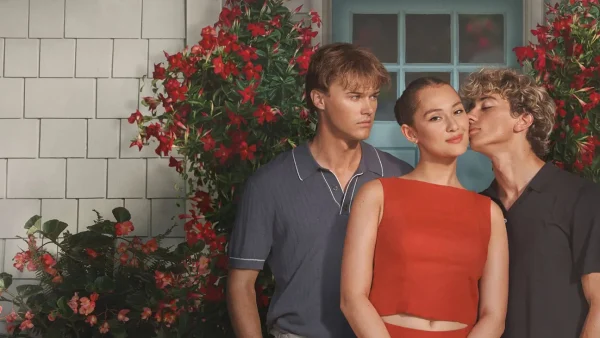Game Review: A love letter to Celeste
Until now, I have never played a video game in full, so I’m clearly qualified to play a difficult platformer and write a review on it.
When it comes to video games, I’ve always been a passive fan. I would often watch walkthroughs, enjoy the content, and that would be all. I’ve been satisfied watching games from the sidelines, mostly because I would definitely not be skilled enough to get through Sans from Undertale’s fight.
However, I’ve been going a little nuts lately, and Celeste, which is usually $19.99, was on sale for $4.99, so I thought to myself: why not? I need something to keep my hands and mind busy, and I’ve heard a lot of praise for this game.
Plus, the main character is trans. It’s subtle (her gender identity has personal connections to the game developer’s, which I thought was interesting), but it’s nice to see a positive portrayal—and in the main character, no less.
The base game usually takes people around eight hours to finish. I finished it on March 19 2023, after 19 hours and 45 minutes of gameplay. You’ve never seen a guy so good at gaming, I know. Still, I think there’s some merit in knowing how accessible games are for complete beginners.
For anyone who doesn’t want spoilers or simply doesn’t want to read all of this: it’s a wonderful game with a heartfelt story, and I enjoyed it immensely even though I sucked at it. Play it!
Overall Gameplay
Before I get into this, here’s a walkthrough of the game, for those who are curious to see the actual gameplay.
Celeste is a 2D precision platformer about climbing a mountain. The player character is a young woman named Madeline, who has depression and anxiety. Celeste Mountain is a pretty clear allegory for personal struggles. Madeline wants—or needs—to climb the mountain, in order to challenge herself and face her problems.
There are seven levels called “chapters” in the base game. When it comes to notable controls, Madeline can dash once, launching her in a single direction. This dash regenerates once she gets onto the ground again.
The first thing I noticed was that Madeline is really nice to play as. Around the same time I started Celeste, I started Cave Story, which has floaty physics that are hard to work with. Celeste doesn’t have this problem. Madeline’s movements are more grounded, but they don’t feel heavy either.
Also, the way death works in Celeste is incredibly forgiving. Madeline respawns instantly at the beginning of each screen, and most—emphasis on most—screens are relatively short. It spoiled me. With how quick it was, it gave me the impression that if I tried doing a screen over and over again, I’d get it eventually.
The graphics are also fantastic. Celeste’s pixel art style is charming with smooth animation to go along with it. The color palettes for each chapter are vibrant and cohesive. Lena Raine’s masterful music composition amplifies the experience, too. Go give the soundtrack a listen!
Throughout the chapters are strawberries you can collect if you want an extra challenge. They’re often in places straying from the main path, and they’re completely optional. I got a whole 18 out of 175 strawberries. My stats for this run are almost hilariously bad, but hey, cut me some slack. There may be various assist options, but I wanted to get through this game without them—it’s a personal pride thing.
Notable Chapter Gameplay
Each chapter has its own mechanics, most of which I won’t be talking about for the sake of not making this review too much of a synopsis. My favorite is the dream blocks found in Chapter Two, Old Site.
Dream blocks are jelly-like blocks Madeline can dash through in order to gain more distance in one direction. At the beginning of the chapter, they appear gray, dull, and solid. Then, Madeline looks into a mirror, and her reflection breaks out, insulting her. Along with this, the blocks turn colorful, and the music changes.
In the game, she is referred to as “Part of You.” Colloquially, she’s called Badeline. Because she’s bad. And purple. It contrasts with Madeline’s orange-blue color scheme. It’s an obvious metaphor for self-hate, but I think it’s written well for reasons I’ll get into later.
I would personally advocate for her to be called Wadeline, simply because her similarities to Waluigi are striking… but I digress. Either way, these plot explanations are about to sound real silly.
Anyways, Old Site is so fun to play. For me, most other chapters in Celeste are interesting and fun because of the challenge that comes along with them. Old Site, though, is subdued and quiet. It’s much easier than other chapters, seeing as it’s still an introductory level. Playing through it makes me happy—it might be my favorite chapter.
Chapter Three, Celestial Resort, haunts me. It is my dearly detested, least favorite chapter. I wish I could leave a long, anguished keysmash here nothing else. Like this: SDGHOWIADSHSGJSDFIJEOIGSDNJKFDSLGHSDLJFJSDLGKJSDKJF!!!!!!!!!!!!!!!!!!!!!!!
If anything, Celeste teaches you to be precise. Celestial Resort really hammers it into you through its dust bunnies that you have to avoid touching lest you want Madeline to die. Timing is of the essence, and I am certifiably not very good at timing. Please don’t look at my 1,384 deaths and four hours of gameplay on just this chapter.
I’d say it’s necessary to play for the later chapters, but wow is it annoying. Chapter Seven, The Summit, remixes all of the previous chapters into shorter segments, and I let out a distressed groan when I saw Celestial Resort’s setting again.
The wind in Chapter Four is undoubtedly the most annoying mechanic in the game, though. I think that’s self explanatory.
Each chapter is solid, though—I just don’t have too many thoughts on them gameplay wise. Still, they’re good and challenging. They scratch my brain, and they’re satisfying to complete. If there’s a mechanic that bothers me in the gameplay of a chapter, the story (and self-awareness of my inability to play games well) more than makes up for it.
The Story and What it Means to Me
At its core, Celeste is a game about accepting yourself.
It’s obvious in the way Madeline treats Badeline—and vice versa—as the story goes on. They reject each other. Badeline thinks Madeline should have never tried climbing Celeste Mountain, and Madeline wants to get rid of part of herself entirely.
In Reflection, Badeline throws Madeline down the mountain, making her lose all her progress. Badeline’s boss fight in this chapter is probably my favorite moment in the entire game. It’s the opposite of Old Site, where Madeline is running away from herself. Badeline is the one running away, and Madeline is the one who has to reach out and accept her.
Badeline isn’t evil, though. To say that would be to undermine her character. Sure, she might be aggressive, but she is just as complex and scared as Madeline. Madeline has to live with all of herself, anxiety and depression and all. Instead of ignoring her problems, she has to learn to live with them and work through them. They’re a part of her, after all.
She doesn’t reach that conclusion alone, either. She meets Granny, a mean, laughing old lady who lives on the mountain. She’s the one who first suggests reaching out to Badeline in the first place—she pushes Madeline forward in a way Madeline herself can’t.
“Celeste Mountain is a place of healing, dear,” she says. “The first step of healing is confronting the problem.”
Madeline also meets Theo, a hipster guy from Seattle who’s only at the mountain for social media pictures, but helps her nonetheless.
At the end of Chapter Four, he helps her out of a panic attack by using a trick his grandpa taught him. Breathe evenly to keep a feather afloat. At the beginning of Chapter Six, they have a conversation around a campfire about Madeline’s depression. They get to know each other better then.
He says she reminds him of his sister, and that line has utterly ruined me for the foreseeable future. It’s just… too cute…
An anxious wreck of a ghost named Oshiro is also in the third chapter, Celestial Resort. He doesn’t mean much to me, since he disappears until the end, but I see his purpose as being a more self-hating parallel of Madeline.
Back to where I was, though—Madeline finally accepts herself fully when she hugs Badeline. Badeline hugs her back, even after running away for the entire chapter.
“Please. Let’s work together,” says Madeline. “It’s okay to be scared.”
She gains another dash, and Badeline helps her jump to places she wouldn’t have been able to reach on her own. It helps both the story and the gameplay. She climbs up the mountain again to reach the summit, with help from her other self that she initially hated so much.
This doesn’t mean everything is miraculously fixed for Madeline, though. She still struggles. She simply deals with it in a better way. When she reaches the summit, there are more mountains to be seen in the distance.
There are two extra chapters to play if you so please, both of which are quite the challenge. There are B-sides and C-sides for each chapter. And golden strawberries… and crystal hearts… and…
You get the point. It leaves you wanting more. The struggle never really ends.
Celeste executes common tropes very well, in my opinion. I think part of that is due to the fact that it’s a game rather than a story or show. It’s interactive, and you play a direct part in what Madeline does, so Madeline’s struggles become your struggles. You are the one trying to reach the summit.
(The game is your mountain. Look at that. You’re the one trying to finish Celeste and putting your head in your hands as you fail a screen for the 50th time.)
Even though I finished it only recently, this game means a lot to me. It’s been a bad week, a bad month, a bad year. I think Celeste helped me through some of my own problems, in a way. Its direct message of accepting yourself and dealing with your emotions rather than ignoring them hits close to home.
You have to take care of yourself before you can help others. It’s okay to ask for help. It’s unproductive to be angry towards yourself all the time. Though they’re basic messages, it’s easy to forget them when you’re lost in the sauce of depression and anxiety.
There’s a reason why people—including me, hi!—won’t shut up about it. It’s a lovingly crafted, personal game that resonates with many. The story and gameplay work together effortlessly.
All in all, I loved this game. Obviously. I don’t think I did it justice with how I wrote about it here, so I’d highly recommend buying it and playing it. It goes on sale a lot, so you can get a lot of good content for five smackaroos.
Now go climb that mountain.

R.K.O. Pablo is a senior, and it's their second year on the newspaper. They've been drawing for years, and they create the graphics for the Charger Online's...





